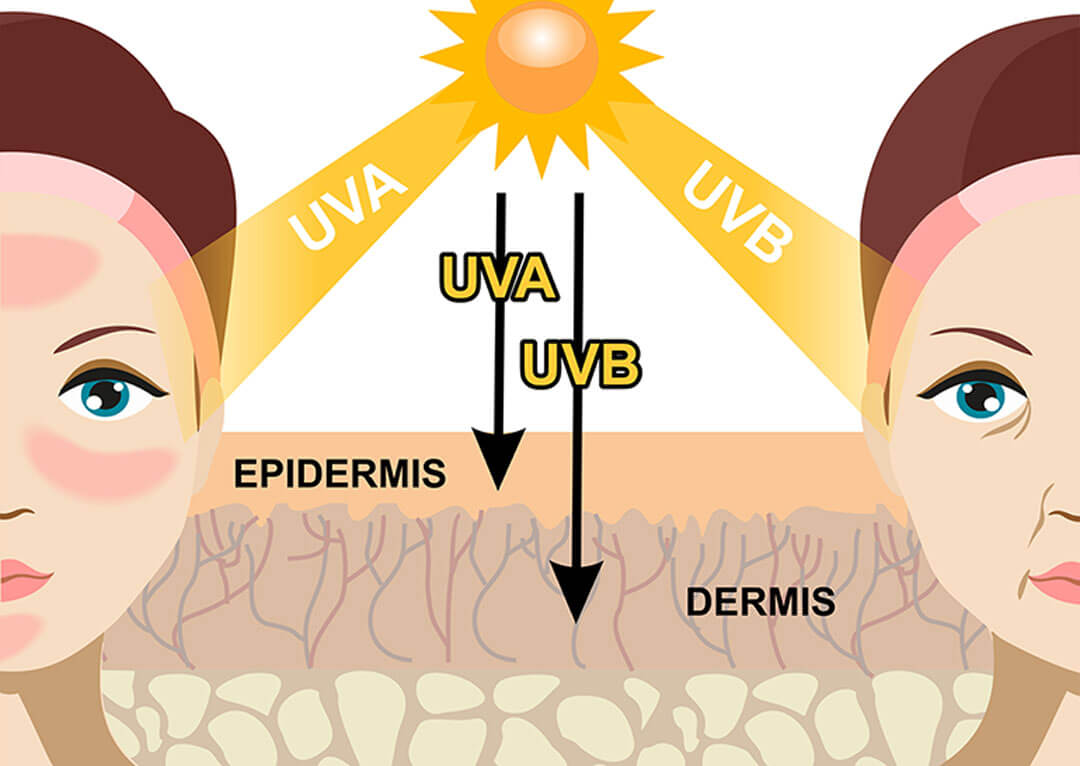
Firstly, let me share that our therapists only wear the tinted AlumierMD sunscreen, no foundation! We know we are protected from the rays from our windows whilst moiturising and giving us a clear healthy finish. Add a bit of lippy and mascara and that’s us for the day.
Short-term sun damage presents as a sunburn. Long-term, unprotected exposure causes gradual damage to skin known as sun damage or photoaging, and accounts for about 90% of the signs of skin aging. The two main types of damaging rays are UVB and UVA. They damage skin cells and their DNA, leading to fine lines, wrinkles, irregular pigmentation, visible vessels, thinned skin, loss of elasticity and skin cancer (including melanoma). This damage occurs directly by the incoming UV photons and indirectly by free radicals that are generated by these rays.
UVA rays (320-400nm) can pass through glass and clouds and are present every day of the year at equal intensity during all daylight hours. They account for 95% of UV rays that reach the earth. Since UVA rays are longer in wavelength than UVB, they are able to penetrate into the deeper skin layers (dermis) affecting collagen, elastin and blood vessels. UVA plays a major role in photoaging. It can also damage skin cells in the basal layer of the epidermis where most skin cancers arise (e.g. basal cell and squamous cell carcinoma). UVA light is used in tanning booths, causing the same skin and eye damage as natural sunlight.
UVB rays (290-320nm) are the main cause of tan and sunburn because they damage the skin’s more superficial epidermal layers. UVB rays play a big part in the development of skin cancer, and a contributory role in photoaging and tanning. UVB rays account for 5% of the sun’s rays and vary according to season and weather conditions; they are more intense in the summer and at high altitudes. Over the last 25 years, more UVB rays have been penetrating the atmosphere because of the thinning ozone layer, increasing the risk for UBV-related sun damage. The SPF number shows the level of protection from UVB rays.
More focus has been placed on IR rays in the last few years. These rays are absorbed by the skin, converted into heat and contribute to photoaging along with UVA and UVB.
The most important item to look for on a sunscreen label is the term “broad spectrum”, signifying coverage against both UVA and UVB rays. The SPF should be 30 or higher. An SPF of 30 blocks 96.7% of UV rays so that only 3.3% will get through, compared with an SPF of 15 which blocks 93.3% of UV rays and lets through 6.7% – twice as much.
Sunscreen is also a must for protecting the skin from free radicals. However, sunscreens only protect up to 55%, not 100%, of free radicals. (Haywood, R., et al, J Invest Dermatol 2006;121:862-868)
Topical antioxidants have been shown to protect skin from damaging free radicals caused by UV rays. Different antioxidants work via different mechanisms to neutralize damage. Therefore, AlumierMD sunscreens are packed with different types of antioxidants for a full range of protection.
A tan results from injury to the skin’s DNA. The skin darkens into a tan as a flawed attempt to protect itself and prevent further DNA damage. However, these flaws or mutations can lead to skin cancer over time. Remember: There is no such thing as a safe tan because a tan equals sun damage.
How to protect against photodamage
Broad Spectrum Sunscreen to protect from both UVA and UVB rays
Antioxidants to protect against free radical damage
AlumierMD Sunscreens
Other Sun Safety Tips
Limit your sun exposure. Stay out of the sun when it is strongest, between 11 a.m. and 4 p.m. Find shade under a tree or an umbrella.
Cover up. Wear a wide-brimmed hat and light-colored long-sleeve shirts and pants. Find sunglasses that protect against UVA and UVB rays.
Use sunscreen correctly. Use enough sunscreen (1/4 tsp for your face, 1 oz for your body). Wear sunscreen every day; if you’re outside for extended periods, reapply every 2-3 hours and after swimming, washing, towel drying or heavy perspiring.
Never use tanning beds!
So there you have it! AlumierMD’s scientific research and knowledge to produce their FANTASTIC broadscreen range of products.
BOOK A FREE SKIN CONSULTATION OR COLOUR MATCHING SERVICE TO GET STARTED.

